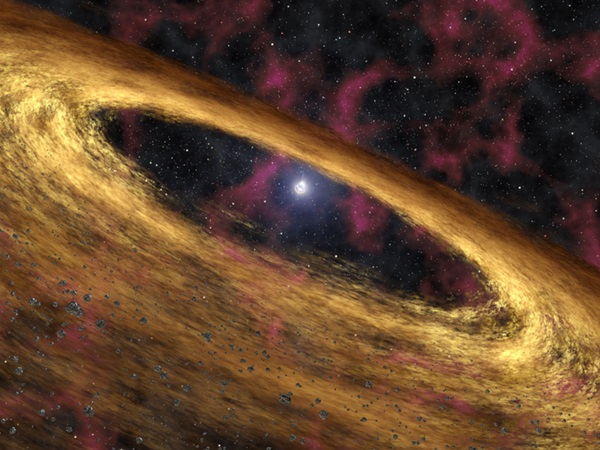NASA’s Spitzer Space Telescope has spied planet-forming ingredients in a disk surrounding pulsar 4U 0142+61. Scientists speculate pulsar planets — planets that form from material in the debris disk surrounding a pulsar — may be the norm instead of the exception.
A pulsar is a spinning neutron star that emits radio and light waves. X-ray pulsars, like pulsar 4U 0142+61, also emit X rays. Twin jets of these waves leave a pulsar. Each jet produces an intense beam of light that appears to pulse as the beam sweeps across an observer’s field of vision each time the dead star’s core completes a rotation.
Pulsar 4U 0142+61 lies 13,000 light-years distant in the constellation Cassiopeia. The pulsar was once a bright, massive star between 10 and 20 times the Sun’s mass. The star collapsed and exploded in a supernova some 100,000 years ago, ejecting dust and debris that fell into orbit around the pulsar. Spitzer’s infrared camera detected the warm dusty disk.
In 1992, Aleksander Wolszczan of Pennsylvania State University discovered three planets orbiting pulsar PSR B1257+12. “I find it very exciting to see direct evidence that the debris around a pulsar is capable of forming itself into a disk. This might be the beginning of a second generation of planets,” says Wolszczan. The first generation of planets around pulsar 4U 0142+61, if there was one, was likely obliterated in the supernova explosion.
The discovery of a disk around pulsar 4U 0142+61 suggests planet-forming material may surround many pulsars. “We’re amazed that the planet-formation process seems to be so universal,” says Deepto Chakrabarty of the Massachusetts Institute of Technology in Cambridge and principal investigator of the team that uncovered the debris disk around pulsar 4U 0142+61.
The research team’s results appear in the April 6 issue of Nature.










